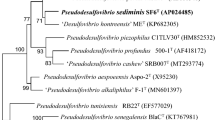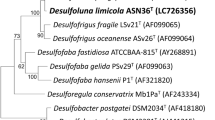Abstract
A new moderately halophilic sulfate-reducing bacterium (strain H T1 ) was enriched and isolated from a wastewater digestor in Tunisia. Cells were curved, motile rods (2–3 x 0.5 μm). Strain H T1 grew at temperatures between 22 and 43°C (optimum 35°C), and at pH between 5.0 and 9.2 (optimum 7.3–7.5). Strain H T1 required salt for growth (1–45 g of NaCl/l), with an optimum at 20–30 g/l. Sulfate, sulfite, thiosulfate, and elemental sulfur were used as terminal electron acceptors but not nitrate and nitrite. Strain H T1 utilized lactate, pyruvate, succinate, fumarate, ethanol, and hydrogen (in the presence of acetate and CO2) as electron donors in the presence of sulfate as electron acceptor. The main end-products from lactate oxidation were acetate with H2 and CO2. The G + C content of the genomic DNA was 55%. The predominant fatty acids of strain H T1 were C15:0 iso (38.8%), C16:0 (19%), and C14:0 iso 3OH (12.2%), and menaquinone MK-6 was the major respiratory quinone. Phylogenetic analysis of the small-subunit (SSU) ribosomal RNA (rRNA) gene sequence indicated that strain H T1 was affiliated to the genus Desulfovibrio. On the basis of SSU rRNA gene sequence comparisons and physiological characteristics, strain H T1 is proposed to be assigned to a novel species of sulfate reducers of the genus Desulfovibrio, Desulfovibrio legallis sp. nov. (= DSM 19129T = CCUG 54389T).


Similar content being viewed by others
References
Barton LL, Fauque GD (2009) Biochemistry, physiology and biotechnology of sulfate-reducing bacteria. In: Laskin A, Gadd G, Sariasiani S (eds) Advances in applied microbiology, vol 68, Chapter 2. Elsevier Inc, San Diego, pp 41–98
Ben Dhia Thabet O, Bouallagui H, Cayol JL, Ollivier B, Fardeau ML, Hamdi M (2009) Anaerobic degradation of landfill leachate using an upflow anaerobic fixed-bed reactor with microbial sulfate reduction. J Hazard Mater 167:1133–1140
Benson DA, Boguski MS, Lipman DJ, Ostell J, Ouellette BF, Rapp BA, Wheeler DL (1999) GenBank. Nucleic Acids Res 27:12–17
Cashion P, Holder-Franklin MA, McCully J, Franklin M (1977) A rapid method for the base ratio determination of bacterial DNA. Anal Biochem 81:461–466
Collins MD, Widdel F (1986) Respiratory quinones of sulphate-reducing and sulphur-reducing bacteria: a systematic investigation. Syst Appl Microbiol 8:8–18
Cord-Ruwisch R (1985) A quick method for the determination of dissolved and precipitated sulfides in cultures of sulfate-reducing bacteria. J Microbiol Methods 4:33
Devereux R, He SH, Doyle CL, Orkland S, Stahl DA, LeGall J, Whitman WB (1990) Diversity and origin of Desulfovibrio species: phylogenetic definition of a family. J Bacteriol 172:3609–3619
Fardeau ML, Ollivier B, Patel BKC, Magot M, Thomas P, Rimbault A, Rocchiccioli AF, Garcia JL (1997) Thermotoga hypogea sp. nov., a xylanolytic, thermophilic bacterium from an oil-producing well. Int J Syst Bacteriol 47:1013–1019
Fauque GD (1995) Ecology of sulfate-reducing bacteria. In: Barton LL (ed) Biotechnology handbooks: sulfate-reducing bacteria, chapter 8. Plenum Press, New York, pp 217–241
Fauque G, Ollivier B (2004) Anaerobes: the sulfate-reducing bacteria as an example of metabolic diversity. In: Bull AT (ed) Microbial diversity and bioprospecting, Chapter 17. ASM Press, Washington, pp 169–176
Fröhlich J, Sass H, Babenzien HD, Kuhnigk T, Varma A, Saxena S, Nalepa C, Pfeiffer P, König H (1999) Isolation of Desulfovibrio intestinalis sp. nov. from the hindgut of the lower termite Mastotermes darwiniensis. Can J Microbiol 45:145–152
Hall TA (1999) BioEdit: a user-friendly biological sequence alignment editor and analysis program for Windows 95/98/NT. Nucleic Acids Symp Ser 41:95–98
Haouari O, Fardeau ML, Cayol JC, Fauque G, Casiot C, Elbaz-Poulichet F, Hamdi M, Ollivier B (2008) Thermodesulfovibrio hydrogeniphilus sp. nov., a new thermophilic sulphate-reducing bacterium isolated from a Tunisian hot spring. Syst Appl Microbiol 31:38–42
Hungate RE (1969) A roll-tube method for the cultivation of strict anaerobes. In: Norris JR, Ribbons DW (eds) Methods in microbiology, vol 3B. Academic Press, New York, pp 117–132
Jukes TH, Cantor CR (1969) Evolution of protein molecules. In: Munro HN (ed) Mammalian protein metabolism. Academic Press, New York, pp 211–232
Klouche N, Basso O, Lascourrèges JF, Cayol JC, Thomas P, Fauque G, Fardeau ML, Magot M (2009) Desulfocurvus vexinensis gen. nov., sp. nov., a sulphate-reducing bacterium isolated from a deep subsurface aquifer. Int J Syst Evol Microbiol 59:3100–3104
Loubinoux J, Bisson-Boutelliez C, Miller N, Le Faou A (2002) Isolation of the provisionally named Desulfovibrio fairfieldensis from human periodontal pockets. Oral Microbiol Immunol 17:321–323
Loubinoux J, Valente FMA, Pereira IAC, Costa A, Grimont PAD, Le Faou A (2002) Reclassification of the only species of the genus Desulfomonas, Desulfomonas pigra, as Desulfovibrio piger comb. nov. Int J Syst Evol Microbiol 52:1305–1308
Macfarlane GT, Cummings JH, Macfarlane S (2007) Sulphate-reducing bacteria and the human large intestine. In: Barton LL, Hamilton WA (eds) Sulphate-reducing bacteria. Environmental and engineered systems, chapter 18. Cambridge University Press, Cambridge, pp 503–521
Maidak BL, Cole JR, Lilburn TG, Parker CT Jr, Saxman PR, Farris RJ, Garrity GM, Olsen GJ, Schmidt TM, Tiedje JM (2001) The RDP-II (Ribosomal Database Project). Nucleic Acids Res 29:173–174
Mesbah M, Premachandran U, Whitman WB (1989) Precise measurement of the G+C content of deoxyribonucleic acid by high-performance liquid chromatography. Int J Syst Bacteriol 39:159–167
Moura JJG, Gonzalez P, Moura I, Fauque G (2007) Dissimilatory nitrate and nitrite ammonification by sulphate-reducing eubacteria. In: Barton LL, Hamilton WA (eds) Sulphate-reducing bacteria. Environmental and engineered systems, chapter 8. Cambridge University Press, Cambridge, pp 241–264
Ollivier B, Cayol JL, Fauque G (2007) Sulphate-reducing bacteria from oil field environments and deep-sea hydrothermal vents. In: Barton LL, Hamilton WA (eds) Sulphate-reducing bacteria. Environmental and engineered systems, chapter 10. Cambridge University Press, Cambridge, pp 305–328
Postgate JR (1959) A diagnostic reaction of Desulphovibrio desulphuricans. Nature 183:481–482
Saitou N, Nei M (1987) The neighbor-joining method: a new method for reconstructing phylogenetic trees. Mol Biol Evol 4:406–425
Ueki A, Suto T (1979) Cellular fatty acid composition of sulfate-reducing bacteria. J Gen Appl Mocrobiol 25:185–196
Vainshtein M, Hippe H, Kroppenstedt RM (1992) Cellular fatty acid composition of Desulfovibrio species and its use in classification of sulfate-reducing bacteria. Syst Appl Microbiol 15:554–566
Warren YA, Citron DM, Vreni Meriam C, Goldstein EJC (2005) Biochemical differentiation and comparison of Desulfovibrio species and other phenotypically similar genera. J Clin Microbiol 43:4041–4045
Widdel F, Pfennig N (1984) Studies on dissimilatory sulfate-reducing bacteria that decompose fatty acids. 1. Isolation of new sulfate-reducing bacteria enriched with acetate from saline environments. Description of Desulfobacter postgatei gen. nov., sp. nov. Arch Microbiol 129:395–400
Author information
Authors and Affiliations
Corresponding author
Rights and permissions
About this article
Cite this article
Thabet, O.B.D., Wafa, T., Eltaief, K. et al. Desulfovibrio legallis sp. nov.: A Moderately Halophilic, Sulfate-Reducing Bacterium Isolated from a Wastewater Digestor in Tunisia. Curr Microbiol 62, 486–491 (2011). https://doi.org/10.1007/s00284-010-9733-z
Received:
Accepted:
Published:
Issue Date:
DOI: https://doi.org/10.1007/s00284-010-9733-z




